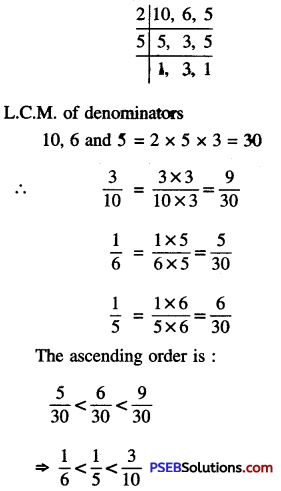Punjab State Board PSEB 6th Class Maths Book Solutions Chapter 5 Fractions Ex 5.4 Textbook Exercise Questions and Answers.
PSEB Solutions for Class 6 Maths Chapter 5 Fractions Ex 5.4
1. Find the different set of like fractions:

Solution:

![]()
2. Write any three like fractions of:
Question (i)
(i) \(\frac {2}{5}\)
(ii) \(\frac {1}{4}\)
(iii) \(\frac {11}{6}\)
Solution:
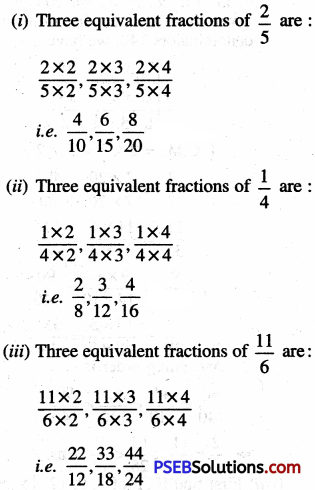
3. Encircle unit fractions:

Solution:
\(\frac{1}{8}, \frac{1}{9}, \frac{1}{7}\)
4. Fill in the boxes with >, < or =
Question (i)
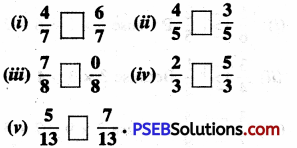
Solution:
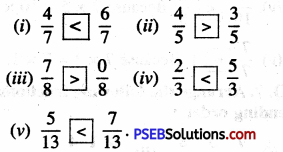
![]()
5. Compare using >, < or =
Question (i)
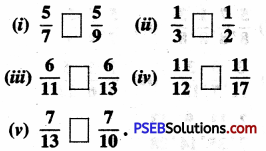
Solution:
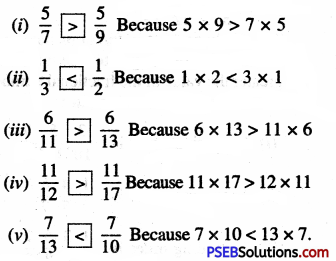
6. Compare using >, < or =
Question (i)
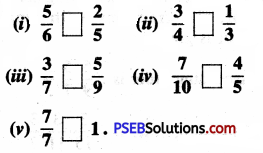
Solution:

7. Arrange the following fractions in ascending order:
Question (i)
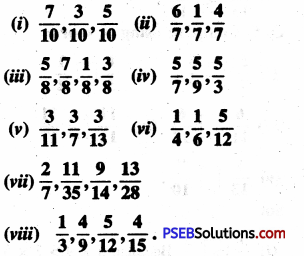
Solution:
We know that in fractions having the same denominator the greater the numerator, the greater the value of the fractional numbers. Therefore the given fractions in:
(i) Ascending order is : \(\frac{3}{10}, \frac{5}{10}, \frac{7}{10}\)
(ii) Ascending order is : \(\frac{1}{7}, \frac{4}{7}, \frac{6}{7}\)
(iii) Ascending order is : \(\frac{1}{8}, \frac{3}{8}, \frac{5}{8}, \frac{7}{8}\)
We know that in fractions having the same numerator, the fractions with smaller denominator is greater:
(iv) Ascending order is : \(\frac{5}{9}, \frac{5}{7}, \frac{5}{3}\)
(v) Ascending order is : \(\frac{3}{13}, \frac{3}{11}, \frac{3}{7}\)
(vi) First find L.C.M. of denominators 4, 6, 12. Now, we convert the given fractions into fractions with denominator 12, we have:
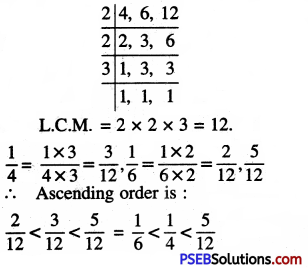
(vii) First find L.C.M. of denominators 7, 35, 14, 28. Now, we convert the given fraction into fractions with denominators 140, we have
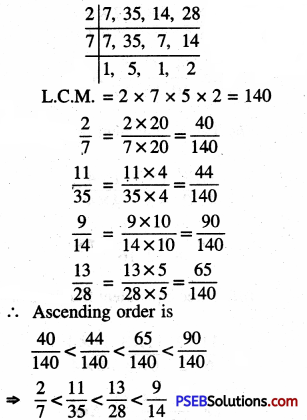
(viii) First find HCF of 3, 9, 12, 15. Now we convert the given fractions into fractions with denominator 180, we have:

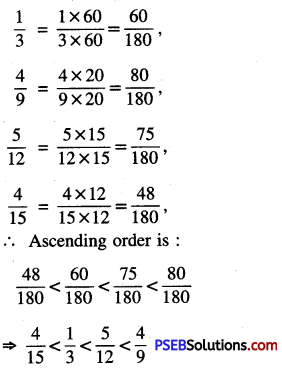
![]()
8. Arrange the following fractions in descending order:
Question (i)
\(\frac{5}{9}, \frac{7}{9}, \frac{1}{9}\)
Solution:
If two or more fractions having the same denominator then fraction with greater numerator is greater fraction:
(i) Descending order is : \(\frac{7}{9}, \frac{5}{9}, \frac{1}{9}\)
Question (ii)
\(\frac{3}{11}, \frac{5}{11}, \frac{2}{11}, \frac{7}{11}\)
Solution:
Descending order is : \(\frac{7}{11}, \frac{5}{11}, \frac{3}{11}, \frac{2}{11}\)
If two or more fractions having the same numerator then the fraction with a small denominator is greater.
Question (iii)
\(\frac{2}{7}, \frac{2}{13}, \frac{2}{9}\)
Solution:
Descending order is : \(\frac{2}{7}, \frac{2}{9}, \frac{2}{13}\)
Question (iv)
\(\frac{1}{5}, \frac{1}{3}, \frac{1}{8}, \frac{1}{2}\)
Solution:
Descending order is : \(\frac{1}{2}, \frac{1}{3}, \frac{1}{5}, \frac{1}{8}\)
Question (v)
\(\frac{1}{6}, \frac{5}{12}, \frac{5}{18}, \frac{2}{3}\)
Solution:
First find L.C.M. of denominators 6, 12, 18, 3.
Now, we convert the given fractions into a fraction with denominator 36, we have:
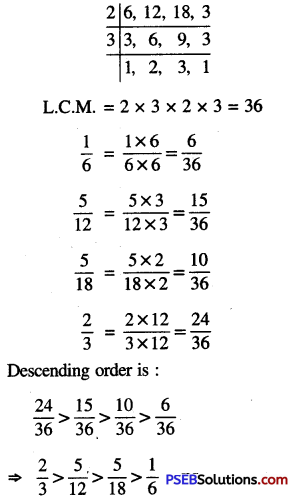
Question (vi)
\(\frac{3}{4}, \frac{9}{20}, \frac{11}{15}, \frac{17}{30}\)
Solution:
First find L.C.M. of denominator 4, 20,15, 30. Now, we convert the given fractions into a fraction with denominator 60, we have:
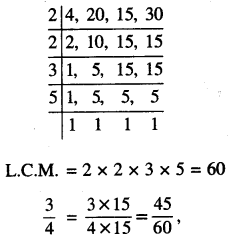
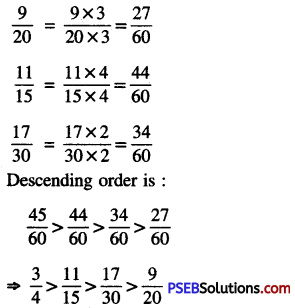
9. Kasvi covered \(\frac {1}{3}\) of her journey by car, \(\frac {1}{5}\) by rickshaw and \(\frac {2}{15}\) on foot. Find by which means, she covered the major part of her journey.
Solution:
Journey covered by car = \(\frac {1}{3}\)
Journey covered by Rickshaw = \(\frac {1}{5}\)
Journey covered on foot = \(\frac {2}{15}\)
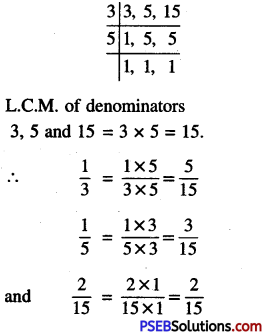
We observe that \(\frac {5}{15}\) i.e. \(\frac {1}{3}\) is the greatest.
Hence the major part of journey was covered by car.
![]()
10. Father distributed his property among his three sons. The eldest one got \(\frac {3}{10}\), the middle got \(\frac {1}{6}\) and the youngest got \(\frac {1}{5}\) part of the property. State how the property was distributed in ascending order.
Solution:
Property eldest son got = \(\frac {3}{10}\) part
Property middle son got = \(\frac {1}{6}\) part
and Property youngest son got = \(\frac {1}{5}\) part
